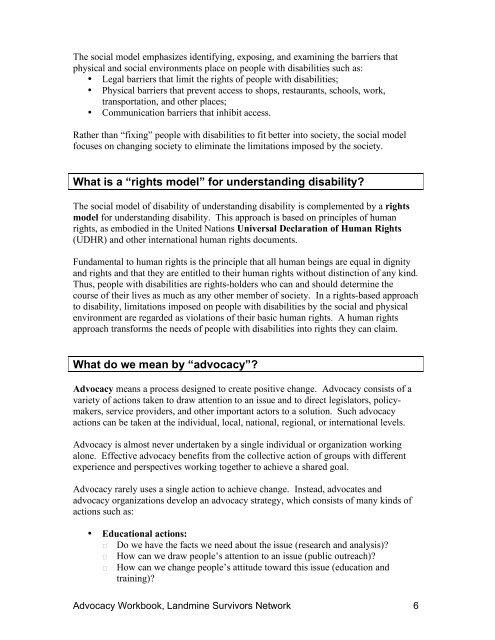Disability Rights Advocacy Workbook - Handicap International
Disability Rights Advocacy Workbook - Handicap International
Disability Rights Advocacy Workbook - Handicap International
Create successful ePaper yourself
Turn your PDF publications into a flip-book with our unique Google optimized e-Paper software.
The social model emphasizes identifying, exposing, and examining the barriers thatphysical and social environments place on people with disabilities such as:• Legal barriers that limit the rights of people with disabilities;• Physical barriers that prevent access to shops, restaurants, schools, work,transportation, and other places;• Communication barriers that inhibit access.Rather than “fixing” people with disabilities to fit better into society, the social modelfocuses on changing society to eliminate the limitations imposed by the society.What is a “rights model” for understanding disability?The social model of disability of understanding disability is complemented by a rightsmodel for understanding disability. This approach is based on principles of humanrights, as embodied in the United Nations Universal Declaration of Human <strong>Rights</strong>(UDHR) and other international human rights documents.Fundamental to human rights is the principle that all human beings are equal in dignityand rights and that they are entitled to their human rights without distinction of any kind.Thus, people with disabilities are rights-holders who can and should determine thecourse of their lives as much as any other member of society. In a rights-based approachto disability, limitations imposed on people with disabilities by the social and physicalenvironment are regarded as violations of their basic human rights. A human rightsapproach transforms the needs of people with disabilities into rights they can claim.What do we mean by “advocacy”?<strong>Advocacy</strong> means a process designed to create positive change. <strong>Advocacy</strong> consists of avariety of actions taken to draw attention to an issue and to direct legislators, policymakers,service providers, and other important actors to a solution. Such advocacyactions can be taken at the individual, local, national, regional, or international levels.<strong>Advocacy</strong> is almost never undertaken by a single individual or organization workingalone. Effective advocacy benefits from the collective action of groups with differentexperience and perspectives working together to achieve a shared goal.<strong>Advocacy</strong> rarely uses a single action to achieve change. Instead, advocates andadvocacy organizations develop an advocacy strategy, which consists of many kinds ofactions such as:• Educational actions:Do we have the facts we need about the issue (research and analysis)?How can we draw people’s attention to an issue (public outreach)?How can we change people’s attitude toward this issue (education andtraining)?<strong>Advocacy</strong> <strong>Workbook</strong>, Landmine Survivors Network 6

















